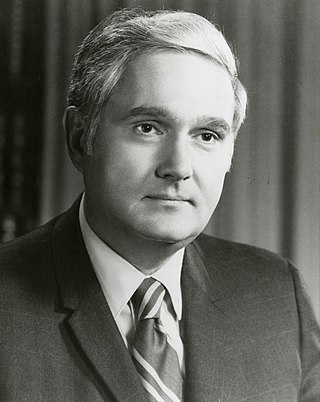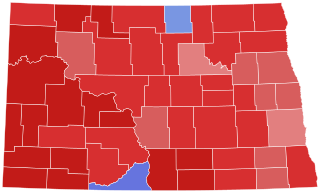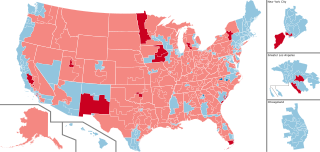
The governor of North Dakota is the head of government of North Dakota and serves as the commander-in-chief of the state's military forces.

The 1986 United States Senate elections were elections for the United States Senate. Held on November 4, in the middle of Ronald Reagan's second presidential term, the 34 seats of Class 3 were contested in regular elections. The Republicans had to defend an unusually large number of freshman Senate incumbents who had been elected on President Ronald Reagan's coattails in 1980. Democrats won a net of eight seats, defeating seven freshman incumbents, picking up two Republican-held open seats, and regaining control of the Senate for the first time since January 1981. This remains the most recent midterm election cycle in which the sitting president's party suffered net losses while still flipping a Senate seat.

The 1974 United States Senate elections were held on November 4, with the 34 seats of Class 3 contested in regular elections. They occurred in the wake of the Watergate scandal, Richard M. Nixon's resignation from the presidency, and Gerald Ford's subsequent pardon of Nixon. Economic issues, specifically inflation and stagnation, were also a factor that contributed to Republican losses. As an immediate result of the November 1974 elections, Democrats made a net gain of three seats from the Republicans, as they defeated Republican incumbents in Colorado and Kentucky and picked up open seats in Florida and Vermont, while Republicans won the open seat in Nevada. Following the elections, at the beginning of the 94th U.S. Congress, the Democratic caucus controlled 60 seats, and the Republican caucus controlled 38 seats.

The 1968 United States Senate elections were elections for the United States Senate. Held on November 5, the 34 seats of Class 3 were contested in regular elections. They coincided with the presidential election of the same year. The Republicans picked up five net seats in the Senate. This saw Republicans win a Senate seat in Florida for the first time since Reconstruction.

The 1962 United States Senate elections was an election for the United States Senate. Held on November 6, the 34 seats of Class 3 were contested in regular elections. Special elections were also held to fill vacancies. They occurred in the middle of President John F. Kennedy's term. His Democratic Party made a net gain of four seats from the Republicans, increasing their control of the Senate to 68–32. However, this was reduced to 67–33 between the election and the next Congress, as on November 18, 1962, Democrat Dennis Chávez, who was not up for election that year, died. He was replaced on November 30, 1962, by Republican appointee Edwin L. Mechem. Additionally, Democrat Strom Thurmond became a Republican in 1964, further reducing Democrats to 66–34. This was the first time since 1932 that Democrats gained seats in this class of Senators.

The 1960 United States Senate elections coincided with the election of John F. Kennedy as president on November 8, 1960. The 33 seats of Class 2 were contested in regular elections. A special election was also held on June 28, 1960, for a mid-term vacancy in North Dakota where Democrats flipped a seat to expand their majority to 66–34. As Majority Leader Lyndon Johnson was elected Vice President, Mike Mansfield became the new majority leader.

The 1958 United States Senate elections were elections for the United States Senate which occurred in the middle of President Dwight D. Eisenhower's second term. Thirty-two seats of Class 1 were contested in regular elections, the new state of Alaska held its first Senate elections for its Class 2 and 3 seats, and two special elections were held to fill vacancies.

Mark Andrews was an American politician from the state of North Dakota. He was a member of the Republican Party and served as a U.S. senator.

The 1936 United States Senate elections coincided with the reelection of President Franklin D. Roosevelt. The 32 seats of Class 2 were contested in regular elections, and special elections were held to fill vacancies. The Great Depression continued and voters backed progressive candidates favoring Roosevelt's New Deal in races across the country. The Democrats gained 5 net seats during the election, and in combination with Democratic and Farmer–Labor interim appointments and the defection of George W. Norris from the Republican Party to become independent, the Republicans were reduced to 16 seats. Democrats gained a further two seats due to mid-term vacancies. The Democrats' 77 seats and their 62-seat majority remain their largest in history.

The 1926 United States Senate elections were elections for the United States Senate that occurred in the middle of Republican President Calvin Coolidge's second term. The 32 seats of Class 3 were contested in regular elections, and special elections were held to fill vacancies. The Republican majority was reduced by seven seats.
A Massachusetts general election was held on November 6, 1962, in the Commonwealth of Massachusetts.

The 2020 North Dakota gubernatorial election was held on November 3, 2020, to elect the Governor and Lieutenant Governor of North Dakota, concurrently with other federal and statewide elections, including the U.S. presidential election. Incumbent Republican Governor Doug Burgum and Lieutenant Governor Brent Sanford were both re-elected to a second term.

The 2020 United States House of Representatives elections were held on November 3, 2020, to elect representatives from all 435 congressional districts across each of the 50 U.S. states to the 117th United States Congress, as well as six non-voting delegates from the District of Columbia and the inhabited U.S. territories. Special House elections were also held on various dates throughout 2020.

North Dakota has held two statewide elections in 2020: a primary election on Tuesday, June 9, and a general election on Tuesday, November 3. In addition, each township has elected officers on Tuesday, March 17, and each school district held their elections on a date of their choosing between April 1 and June 30.

The 1968 North Dakota gubernatorial election was held on November 5, 1968. Incumbent Democrat William L. Guy defeated Republican nominee Robert P. McCarney with 54.82% of the vote.

The 1964 North Dakota gubernatorial election was held on November 3, 1964. Incumbent Democrat William L. Guy defeated Republican nominee Donald M. Halcrow with 55.74% of the vote.

The 1960 North Dakota gubernatorial election was held on November 8, 1960. Democratic nominee William L. Guy defeated Republican nominee and Lieutenant Governor Clarence P. Dahl with 49.44% of the vote.

The 1936 North Dakota gubernatorial election was held on November 3, 1936. Nonpartisan League nominee William Langer defeated incumbent Republican Walter Welford with 35.80% of the vote.

The 1922 North Dakota gubernatorial election was held on November 7, 1922. Incumbent Republican Ragnvald Nestos defeated Nonpartisan League nominee William Lemke with 57.65% of the vote.

The 2018 United States attorney general elections were held on November 6, 2018, in 30 states, 2 territories, and the District of Columbia. The previous attorney general elections for this group of states took place in 2014, except in Vermont where attorneys general serve only two-year terms and elected their current attorney general in 2016.





















